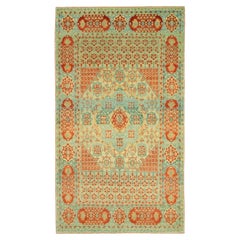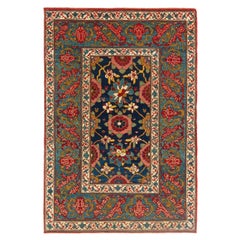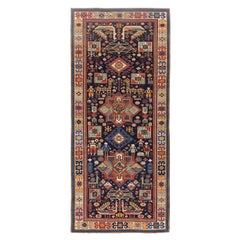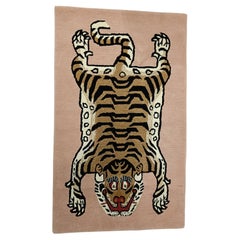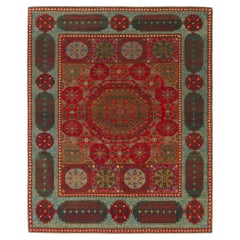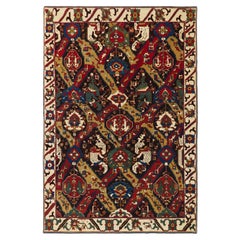21st Century and Contemporary Rugs
465
9
to
14
78
10
474
119
315
252
3
2
1
1
1
140
699
474
220
271
71
7
8
21
23
15
23
21
22
9
5
469
386
97
97
59
404
284
282
111
103
281
92
21
14
7
Period: 21st Century and Contemporary
Ararat Rugs The Simonetti Mamluk Carpet 16th C. Revival Rug, Square Natural Dyed
By Ararat Rugs
Located in Tokyo, JP
The source of carpet comes from the book How to Read - Islamic Carpets, Walter B. Denny, The Metropolitan Museum of Art, New York 2014 fig.61,62. The five-star-medallion carpet was d...
Category
Turkish Revival 21st Century and Contemporary Rugs
Materials
Wool, Organic Material, Natural Fiber
Ararat Rugs Mina Khani Rug with Bidjar Border Persian Revival Carpet Natural Dye
By Ararat Rugs
Located in Tokyo, JP
The design source of the rug comes from the book Antique Rugs of Kurdistan A Historical Legacy of Woven Art, James D. Burns, 2002 nr.4. This was an exclusive example of a Mina Khani ...
Category
Turkish Revival 21st Century and Contemporary Rugs
Materials
Wool, Natural Fiber, Organic Material
Ararat Rugs Akstafa Kazak Rug, 19th C. Caucasian Revival Carpet Natural Dyed
By Ararat Rugs
Located in Tokyo, JP
The source of the rug comes from the book Orient Star – A Carpet Collection, E. Heinrich Kirchheim, Hali Publications Ltd, 1993 nr.7. This rug is from the late 19th century, Kazak re...
Category
Caucasian Revival 21st Century and Contemporary Rugs
Materials
Wool, Natural Fiber, Organic Material
Contemporary Mughal Tiger design wool Rug Home décor Interior design Carpets
Located in London, GB
Contemporary Mughal Tiger design wool Rug Home décor Interior design Carpets
Cool Mughal design Tiger wool rug in pink background
New hand crafted in India
Size 150 x 90cm
Category
Tibetan 21st Century and Contemporary Rugs
Materials
Wool, Cotton
Ararat Rugs The Simonetti Mamluk Carpet 16th C. Revival Rug, Square Natural Dyed
By Ararat Rugs
Located in Tokyo, JP
The source of carpet comes from the book How to Read - Islamic Carpets, Walter B. Denny, The Metropolitan Museum of Art, New York 2014 fig.61,62. The five-star-medallion carpet was d...
Category
Turkish Revival 21st Century and Contemporary Rugs
Materials
Wool, Organic Material, Natural Fiber
Ararat Rugs Dragon Rug, Antique Caucasus Museum Revival Carpet, Natural Dyed
By Ararat Rugs
Located in Tokyo, JP
The source of the rug comes from the book Caucasian Carpets, E. Gans-Reudin, Thames and Hudson, Switzerland 1986, pg.37. This luxurious and varied work is known as the Cassirer drago...
Category
Turkish Revival 21st Century and Contemporary Rugs
Materials
Wool, Natural Fiber, Organic Material
Serenity Bliss Medium Tan & White 180X270 cm Handknotted Rug
By JAIPUR RUGS
Located in Milano, IT
Can a rug be the key to transforming your space into a sanctuary of tranquility? Discover 'Serenity Bliss,' a hand-knotted marvel . With a tone-on-tone palette, it instantly uplifts ...
Category
Indian Modern 21st Century and Contemporary Rugs
Materials
Wool
Velvet Verve Ivory Pink Tint 180x270 cm Hand Tufted Rug
By JAIPUR RUGS
Located in Milano, IT
Decorate your space with the unparalleled craftsmanship of this hand tufted rug from our abstract collection, Caliedo. This rug is not just a floor covering carpet, it's a conversati...
Category
Indian Modern 21st Century and Contemporary Rugs
Materials
Wool
Mocha Mirage Medium Tan Silver Gray 240x300 cm Hand Tufted Rug
By JAIPUR RUGS
Located in Milano, IT
Introducing this designer rug from our Cascade collection, a masterpiece that seamlessly blends intricate patterns in a soothing palate. The complex design of this rug is a visual sy...
Category
Indian Modern 21st Century and Contemporary Rugs
Materials
Wool
Linear Grace Natural Beige & Natural Gray 180X270 cm Hand Knotted Rug
By JAIPUR RUGS
Located in Milano, IT
Unveil the allure of soft elegance with this absolutely beautiful wool rug from our Manifest collection, reflecting a harmonious blend of linear precision and abstract charm. The rug...
Category
Indian Modern 21st Century and Contemporary Rugs
Materials
Wool
Urban Mirage Ebony & Snow White 240X300 cm Handtufted Rug
By JAIPUR RUGS
Located in Milano, IT
Have you met 'Urban Mirage',a masterpiece? Crafted like a work of abstract art on a cloth canvas, the handtufted rug unfolds on an ebony canvas with a snow-white border. Made with a ...
Category
Indian Modern 21st Century and Contemporary Rugs
Materials
Wool
Sunlit Melody Honey Yellow & Honey Yellow 240x300 cm Hand Knotted Rugs
By JAIPUR RUGS
Located in Milano, IT
Step into the realm of distinctive elegance with this mesmerizing rug from our Aprezo collection that effortlessly blends abstract artistry with rhythmic design. This wool rug is a v...
Category
Indian Modern 21st Century and Contemporary Rugs
Materials
Wool
Chroma Chic White Medium Fawn 180x270 cm Hand Tufted Rug
By JAIPUR RUGS
Located in Milano, IT
Step into a world of understated elegance with this exquisite rug from our Shudd collection, a testament to the beauty found in simplicity. The design of this hand tufted rug strikes...
Category
Indian Modern 21st Century and Contemporary Rugs
Materials
Wool
Whispering Sands Antique White Hand-Knotted Rug
By JAIPUR RUGS
Located in Milano, IT
Submerged in antique white and white sand, this rug narrates a tale of timeless allure. Hand-knotted with the luxury of wool and bamboo silk, this rug mirrors the artist's inspiratio...
Category
Indian Modern 21st Century and Contemporary Rugs
Materials
Wool
Elysian Bloom White & Soft Gold 240x300 cm Hand Knotted Rug
By JAIPUR RUGS
Located in Milano, IT
Picture a canvas where curvy lines gracefully dance alongside linear precision, forming a symphony of shapes that mirrors the harmonious coexistence of contrasts in life. This rug fr...
Category
Indian Modern 21st Century and Contemporary Rugs
Materials
Wool
Abstract Nature Mink Classic Gray 200X300 Cm Hand-Knotted Rug
By JAIPUR RUGS
Located in Milano, IT
Introducing this hand-knotted rug in mink and classic gray colors with a modern design that finds beauty in errors. Inspired by nature's interruption of mechanical duplication, this ...
Category
Indian Modern 21st Century and Contemporary Rugs
Materials
Silk
Radiant Haze Fog & Fog 240x300 cm Hand Knotted Rug
By JAIPUR RUGS
Located in Milano, IT
Welcome to the epitome of elegance with this beautiful hand tufted silk rug from our Manifest collection. This handwoven masterpiece offers a unique blend of artistry and comfort tha...
Category
Indian Modern 21st Century and Contemporary Rugs
Materials
Silk
Tranquil Treasure White White 180x270 cm Hand Tufted Rug
By JAIPUR RUGS
Located in Milano, IT
In a world where subtle sophistication is often hard to find, our hand tufted rug from the Shudd collection emerges as a silent yet striking maestro, poised to redefine your interior...
Category
Indian Modern 21st Century and Contemporary Rugs
Materials
Wool
Vibrant Voyage Cloud White Cloud White 180x270 cm Hand Tufted Rug
By JAIPUR RUGS
Located in Milano, IT
Immerse your living space in a breath of fresh air with this vibrant rug from our Confetti collection. It's a vibrant masterpiece that effortlessly steals the spotlight in any interi...
Category
Indian Modern 21st Century and Contemporary Rugs
Materials
Wool
Urban Brilliance Soft Beige & White 240X300 cm Handtufted Rug
By JAIPUR RUGS
Located in Milano, IT
Embark on a journey of design excellence with our Handtufted Rug, a masterpiece in soft beige and white, resembling a work of abstract art on a cloth canvas. This rug is the epitome ...
Category
Indian Modern 21st Century and Contemporary Rugs
Materials
Wool
Merging Ripples Vanilla & Ebony 240x300 cm Hand Knotted Rugs
By JAIPUR RUGS
Located in Milano, IT
Embark on a visual journey with this wool rug from our Aprezo collection. The rug's aesthetic is a testament to artistry, with a pattern that delicately intertwines, resembling the p...
Category
Indian Modern 21st Century and Contemporary Rugs
Materials
Wool
Celestial Cluster 240x300 cm Natural Camel Natural Gray Hand Tufted Rug
By JAIPUR RUGS
Located in Milano, IT
Behold the celestial charm of this beautiful rug from our pathways collection. This rug isn't just a comfy layer to the floors but an addition that brings the ethereal beauty of the ...
Category
Indian Modern 21st Century and Contemporary Rugs
Materials
Wool
Infinite Intricacies Cloud White & Rose Smoke 240X300 Cm Handknotted Rug
By JAIPUR RUGS
Located in Milano, IT
Ever dreamt of walking on clouds infused with cultural splendor? This Hand-Knotted Rug, meticulously crafted in rural India , beckons you into an ethereal realm of aesthetics. Intric...
Category
Indian Modern 21st Century and Contemporary Rugs
Materials
Wool
Mellow Waves Light Blue & Peach 240x300 cm Hand Knotted Rug
By JAIPUR RUGS
Located in Milano, IT
Indulge in the serene allure of this rug from our Manifest collection, a true masterpiece that beckons you to step into a world of tranquility and grace. The pattern of this rug is l...
Category
Indian Modern 21st Century and Contemporary Rugs
Materials
Wool
Maze Melody Antique White & Black Olive 240X300 cm Handknotted Rug
By JAIPUR RUGS
Located in Milano, IT
This hand-knotted rug, a modern marvel , is a true testament to artistic exploration, featuring bold and abstract mazes and jigsaws. The antique white ground color sets the stage for...
Category
Indian Modern 21st Century and Contemporary Rugs
Materials
Silk
Eternal Sandstone Antique White & White Sand 240X300 cm Handknotted Rug
By JAIPUR RUGS
Located in Milano, IT
Elevate the mood with this tone-on-tone, hand-knotted rug crafted in rural India. Immerse your surroundings in instant uplift, as the antique white ground and white sand border seaml...
Category
Indian Modern 21st Century and Contemporary Rugs
Materials
Silk
Coastal Serenity White Sand & Sand 240x300 cm Handknotted Rug
By JAIPUR RUGS
Located in Milano, IT
Ever wondered if you could bring the tranquil essence of a beach into your home? Our modern hand-knotted rug, meticulously crafted in rural India, achieves just that. The rug field b...
Category
Indian Modern 21st Century and Contemporary Rugs
Materials
Wool
Ashen Whispers Ashwood Antique White 195X295 cm Hand-Knotted Rug
By JAIPUR RUGS
Located in Milano, IT
Unveil the enchanting tale within this modern, hand-knotted rug , meticulously crafted from wool and bamboo silk, echoing the artisanal whispers of rural India. The ground color, rem...
Category
Indian Modern 21st Century and Contemporary Rugs
Materials
Silk
Tranquil Sky Mosaic Blue Haze Undyed White 180X270 cm Hand-Knotted Rug
By JAIPUR RUGS
Located in Milano, IT
Step into a world of timeless elegance with our hand-knotted rug, meticulously crafted from wool and silk. The enchanting blue haze ground color, akin to a tranquil sky, gracefully m...
Category
Indian Tibetan 21st Century and Contemporary Rugs
Materials
Wool
Earthy Elegance Medium Gray & Warm Taupe 240X300 cm Handknotted Rug
By JAIPUR RUGS
Located in Milano, IT
Embark on a sensory journey with this exquisite creation from the Gauri Khan collection - Tattvam which is designed to immerse your space in the enchanting tales of rural India. Thi...
Category
Indian Tibetan 21st Century and Contemporary Rugs
Materials
Silk
Sublime Comfort White & Honey 180X270 cm Handknotted Rug
By JAIPUR RUGS
Located in Milano, IT
Immerse your space in the subtle elegance of this hand-knotted marvel from rural India. How does a tone-on-tone palette uplift the mood instantly? With a white ground and honey borde...
Category
Indian Modern 21st Century and Contemporary Rugs
Materials
Wool
Monochrome Dreams White & Classic Gray 180x270 cm Hand-Knotted Rug
By JAIPUR RUGS
Located in Milano, IT
Introducing a blend of white and classic gray in wool and bamboo silk, hand-knotted for a modern touch. Inspired by the serene pace of natural processes, it offers a rare luxury in o...
Category
Indian Modern 21st Century and Contemporary Rugs
Materials
Silk
Abstract Harmony Rose Smoke & Nickel 240X300 cm Handknotted Rug
By JAIPUR RUGS
Located in Milano, IT
Celebrate the allure of imperfections with us! Inspired by the intersection of nature and machinery, our rug transforms misprints and interruptions in mechanical duplication into a u...
Category
Indian Modern 21st Century and Contemporary Rugs
Materials
Silk
Artisan Melange Medieval Blue & Medium Gray 200X300 cm Handknotted Rug
By JAIPUR RUGS
Located in Milano, IT
A seamless blend of delicate traditional and tribal motifs in a Transitional style! The handknotted rug boasting intricate patterns creates a harmonious fusion of heritage and contem...
Category
Indian Tribal 21st Century and Contemporary Rugs
Materials
Wool
Luminescent Prism Ashwood & Frost Gray 240X300 cm Handknotted Rug
By JAIPUR RUGS
Located in Milano, IT
Experience the dance of light with this hand-knotted rug inspired by patterns cast by a candle on glass. Handmade in rural India, this modern marvel captures constantly evolving form...
Category
Indian Modern 21st Century and Contemporary Rugs
Materials
Wool
Stormy Shadows Medium Gray Charcoal Slate 240x300 cm Hand Tufted Rug
By JAIPUR RUGS
Located in Milano, IT
Step into the contemporary elegance of this rug from our Genesis collection. This handmade rug displays a pattern that resonates with a contemporary vibe, where shades of medium gray...
Category
Indian Modern 21st Century and Contemporary Rugs
Materials
Silk
Calm Chaos Dark Ivory 240X300 Cm Modern handknotted Rug
By JAIPUR RUGS
Located in Milano, IT
A modern design hand-knotted rug that draws inspiration from the gradual decline of civilizations into disorder! Its intricate patterns reflect this sense of chaos, yet within each t...
Category
Indian Modern 21st Century and Contemporary Rugs
Materials
Wool
Tranquil Oasis White & Swamp Green 255X360 cm Handknotted Rug
By JAIPUR RUGS
Located in Milano, IT
Immerse your space in the grandeur of this transitional hand-knotted rug that transcends time and decor styles. Handmade in rural India, this masterpiece features traditional pattern...
Category
Indian Modern 21st Century and Contemporary Rugs
Materials
Silk
Luminous Whisper White & Linen White 240X300 cm Handknotted Rug
By JAIPUR RUGS
Located in Milano, IT
Have you discovered the transformative power of tone-on-tone palettes? Meet this modern hand-knotted rug , exquisitely crafted in rural India. With a serene white base and a linen wh...
Category
Indian Modern 21st Century and Contemporary Rugs
Materials
Silk
Skyborne Heritage White & Soft Beige 240X300 cm Handknotted Rug
By JAIPUR RUGS
Located in Milano, IT
A masterpiece crafted from a blend of wool and silk, this rug is more than an accessory; it's a portal to tradition in a modern living space! The serene white ground color, gracefull...
Category
Indian Tibetan 21st Century and Contemporary Rugs
Materials
Wool
Peachy Whirl Light Peach Natural Mink 240x300 cm Hand Tufted Rug
By JAIPUR RUGS
Located in Milano, IT
Indulge in the alluring charm of this peachy rug from our Aprezo collection. What sets this rug apart is its whimsical curvy pattern, a delightful departure from the mundane straight lines. Unlike the rigidity of linear designs, the gentle curves on this rug evoke a sense of fluid tranquility, creating an atmosphere that invites relaxation. One can find this beauty in various standard sizes and it is also available for customization in terms of size, color, and shape to help you find a fitting match. The standard sizes available for this piece are 274x365cm, 244x304cm, 183x274cm, 183x183cm, 152x244cm, 123x183cm, 93x152cm, 76x304cm & 303x427cm. The soft palette of light peach and natural mink...
Category
Indian Modern 21st Century and Contemporary Rugs
Materials
Wool
Serene Fusion Nickel & Clay 180X270 cm Handknotted Rug
By JAIPUR RUGS
Located in Milano, IT
Experience the epitome of modern design with our Abstract Hand-Knotted Rug, a tribute to the unhurried cadence of natural processes—a rare luxury in today’s fast-paced world. Meticul...
Category
Indian Modern 21st Century and Contemporary Rugs
Materials
Silk
Lustrous Harmony Liquorice & Shale 240X300 cm Handknotted Rug
By JAIPUR RUGS
Located in Milano, IT
Can a rug become a catalyst for transforming your space? Introducing this hand-knotted marvel from rural India, meticulously crafted to transcend conventional aesthetics. The tone-on...
Category
Indian Modern 21st Century and Contemporary Rugs
Materials
Silk
Harmonic Contrast Ivory & Blackberry 240x300 Cm Handknotted rug
By JAIPUR RUGS
Located in Milano, IT
Introducing this hand-knotted rug , meticulously handcrafted in rural India. With a dark ivory canvas and a border reminiscent of ripe blackberries, the rug showcases geometric desig...
Category
Indian Modern 21st Century and Contemporary Rugs
Materials
Wool
Majestic Harmony Trellis Classic Gray & Shale 240X300 Cm Handknotted Rug
By JAIPUR RUGS
Located in Milano, IT
Can a rug transcend time and style, seamlessly weaving tradition into modernity? Meet this transitional hand-knotted marvel handmade in rural India. Its traditional patterns evoke a ...
Category
Indian Modern 21st Century and Contemporary Rugs
Materials
Wool
Midnight Majesty Sky Blue Smoke Blue 150X240 cm Hand Tufted Rug
By JAIPUR RUGS
Located in Milano, IT
Enchant your living space with the allure of this stunning hand tufted rug from our Mythos collection, it's a masterpiece that seamlessly blends intricate design with an exotic color...
Category
Indian Modern 21st Century and Contemporary Rugs
Materials
Silk
Luxe Overture Mink & Nickel 240X300 cm Hand Knotted Rug
By JAIPUR RUGS
Located in Milano, IT
Embark on a journey of tactile refinement with this stunning wool rug from our Uvenuti collection. The highlight of this rug is its distinctive grainy pattern, reminiscent of life's ...
Category
Indian Modern 21st Century and Contemporary Rugs
Materials
Wool
Echoing Abstract Ivory & White Sand 240x300 cm Handknotted Rug
By JAIPUR RUGS
Located in Milano, IT
This unique creation delves into the beauty of errors, exploring the harmonious intersection of nature's disruptions and mechanical misprints. Inspired by the symbiosis of nature and...
Category
Indian Modern 21st Century and Contemporary Rugs
Materials
Silk
Sahara Dreams Antique White & Honey Yellow 240X300 cm Handknotted Rug
By JAIPUR RUGS
Located in Milano, IT
An exquisite tapestry of Moroccan inspiration and contemporary allure ! Crafted with an all-wool construction in rural India, this handknotted rug transforms eclectic patterns into a...
Category
Indian Modern 21st Century and Contemporary Rugs
Materials
Wool
Serenity Blend Mink & Medium tan 240X300 Cm Handknotted Rug
By JAIPUR RUGS
Located in Milano, IT
Can a rug transform a room? Discover the answer with this modern, hand-knotted masterpiece . Immerse your space in its soothing tone-on-tone palette, instantly uplifting the mood. Wi...
Category
Indian Modern 21st Century and Contemporary Rugs
Materials
Wool
Lustrous Zenith White & Liquorice 240X300 cm Handknotted Rug
By JAIPUR RUGS
Located in Milano, IT
Can a rug redefine your space? Experience the transformative power of the our hand-knotted marvel. Crafted with precision, its tone-on-tone palette instantly uplifts any space, addin...
Category
Indian Modern 21st Century and Contemporary Rugs
Materials
Wool
Serenity Sway Ebony Dark Ivory 180x270 cm Hand Tufted Rug
By JAIPUR RUGS
Located in Milano, IT
Upgrade your living space with the enchanting allure of this rug from our exclusive Transcend collection, a masterpiece that seamlessly blends statement and subtlety. This rug isn't ...
Category
Indian Modern 21st Century and Contemporary Rugs
Materials
Wool
Mystic Labyrinth Warm Sesame & Natural Beige 240X300 cm Handknotted Rug
By JAIPUR RUGS
Located in Milano, IT
Dive into the modern allure of hand-knotted rug , meticulously handmade in rural India. Crafted with the finest quality wool and bamboo silk, it showcases bold and abstract mazes and...
Category
Indian Modern 21st Century and Contemporary Rugs
Materials
Wool
Enchanting Desert Bloom Clay 300X420 cm Hand-Knotted Rug
By JAIPUR RUGS
Located in Milano, IT
Embark on a journey of timeless elegance with our Moroccan-inspired rug, a testament to exquisite craftsmanship. The all-wool construction, hand-knotted by skilled artisans in rural ...
Category
Indian Modern 21st Century and Contemporary Rugs
Materials
Wool
Primitive Harmony Ashwood & Dark Ivory 240X300 cm Handknotted Rug
By JAIPUR RUGS
Located in Milano, IT
Embark on a journey through cultures with us, Transitional Hand-Knotted Rug, a tribute to primitive art worldwide. Meticulously crafted by the most skilled artisans, this masterpiece...
Category
Indian Tribal 21st Century and Contemporary Rugs
Materials
Wool
Ornate Odyssey Dark Ivory & Clay 240X300 cm Handknotted Rug
By JAIPUR RUGS
Located in Milano, IT
Are you looking for a rug that transcends time and space, weaving together tradition and modernity in a harmonious dance of design? Look no further. The masterpiece, meticulously han...
Category
Indian Modern 21st Century and Contemporary Rugs
Materials
Wool
Crystal Cascade Praline Praline 180x270 cm Hand Tufted Rug
By JAIPUR RUGS
Located in Milano, IT
Refine the elegance and comfort of your floors with this exquisite rug from our Pathways collection. The rug's design is a masterpiece of understated beauty, a symphony of praline hu...
Category
Indian Modern 21st Century and Contemporary Rugs
Materials
Wool
Prism Portico Soft Mint Medium Fawn 180x270 cm Hand Tufted Rug
By JAIPUR RUGS
Located in Milano, IT
Dive into the realm of abstract elegance with this exquisite rug from our Caliedo Collection. This rug isn't just a comfort piece, it's a work of art, where abstract patterns weave a...
Category
Indian Modern 21st Century and Contemporary Rugs
Materials
Wool
Recently Viewed
View AllMore Ways To Browse
French Ormolu Display Case
Wood Carved Double Doors
Black Sculptural Dining Room Chairs
Carved Wood Double Doors
Antique Bathroom Cabinet Cabinets
Antique Bathroom Cabinet Furniture
Antique Bathroom Cabinet
French Inlaid Ormolu Mount Cabinets
Dutch Marquetry
Dutch Marquetry Furniture
Antique French Oak Wardrobe
Dining Side Chair Chippendale
Pair Of Arched Doors
Moller Leather
Teak Shelving 1960s
Narrow Cabinets
Period French Bed
Antique Bathroom Cabinets
